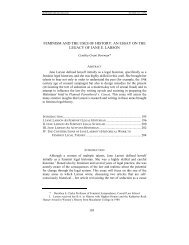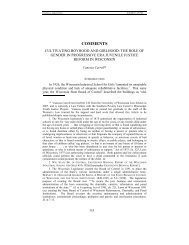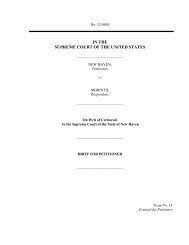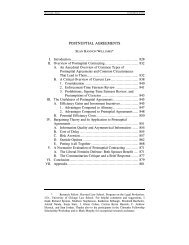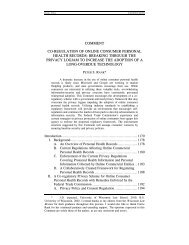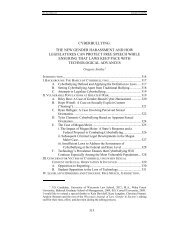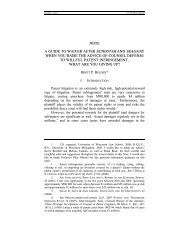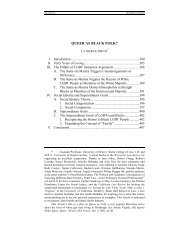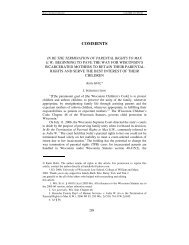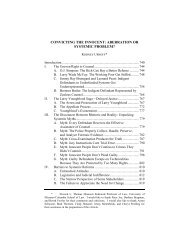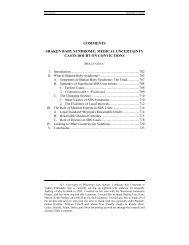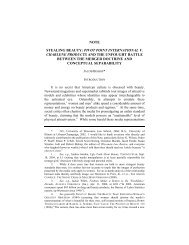comment sketchy eyewitness-identification ... - UW Law School
comment sketchy eyewitness-identification ... - UW Law School
comment sketchy eyewitness-identification ... - UW Law School
You also want an ePaper? Increase the reach of your titles
YUMPU automatically turns print PDFs into web optimized ePapers that Google loves.
MCNAMARA - FINAL 5/20/2009 5:17 PM<br />
772 WISCONSIN LAW REVIEW<br />
criminal justice system, and have been the focus of reforms across the<br />
country. 47 These reforms have included avoiding multiple <strong>identification</strong><br />
procedures with the same suspect; 48 instructing <strong>eyewitness</strong>es prior to a<br />
lineup that the real culprit may or may not be present; 49 using doubleblind<br />
lineups in which the administrator is unaware of the identity of<br />
the suspect; 50 using sequential lineups, in which the participants are<br />
shown to the <strong>eyewitness</strong> one at a time, as opposed to simultaneous<br />
lineups, in which all participants are shown to the <strong>eyewitness</strong> at the<br />
same time; 51 and not giving feedback to <strong>eyewitness</strong>es after they make a<br />
selection. 52 So far, reforms have focused largely on the <strong>identification</strong><br />
itself, rather than procedures leading up to the <strong>identification</strong>, such as<br />
the development of suspects through the use of facial composites. 53<br />
The factors that affect the reliability of <strong>eyewitness</strong> <strong>identification</strong>s<br />
are not always intuitive, and are often counterintuitive. 54 Studies show<br />
47. See, e.g., Gary L. Wells, Eyewitness Identification: Systemic Reforms,<br />
2006 WIS. L. REV. 615, 616 n.9, 634–35, 641–43 [hereinafter Wells, Systemic<br />
Reforms ] (describing <strong>eyewitness</strong>-<strong>identification</strong> reforms in California, Iowa,<br />
Massachusetts, Minnesota, New Jersey, North Carolina, Virginia, and Wisconsin);<br />
Gary L. Wells et al., From the Lab to the Police Station: A Successful Application of<br />
Eyewitness Research, 55 AM. PSYCHOLOGIST 581, 589–95 (2000) (describing the U.S.<br />
Department of Justice’s development of national guidelines for the collection and<br />
preservation of <strong>eyewitness</strong> evidence in response to the role of mistaken <strong>eyewitness</strong><br />
<strong>identification</strong>s in wrongful convictions).<br />
48. See OFFICE OF THE ATTORNEY GEN., WIS. DEP’T OF JUSTICE, MODEL<br />
POLICY AND PROCEDURE FOR EYEWITNESS IDENTIFICATION 6 (2005). Witnesses who may<br />
recognize a suspect they have seen in another procedure believe that it suggests the<br />
suspect is the culprit, or the witness may unconsciously recognize the suspect from the<br />
earlier procedure rather than the original event. Id.<br />
49. Wells & Olson, supra note 41, at 286. Studies show that when witnesses<br />
are given this instruction there is a considerable reduction in mistaken <strong>identification</strong>s<br />
and little effect on accurate <strong>identification</strong>s. Id.<br />
50. Id. at 289. Lineup administrators who are unaware of the identity of the<br />
suspect are unable to provide clues, whether consciously or not, to the <strong>eyewitness</strong>. Id.<br />
51. Id. at 288. Sequential lineups discourage witnesses from engaging in<br />
relative judgment, a process in which people select the participant who most resembles<br />
their memory of the culprit. Id. at 286. Simultaneous lineups are particularly dangerous<br />
when the nonsuspect participants in the lineup, known as fillers, differ from the written<br />
description of the culprit because they can be easily eliminated, particularly if the<br />
suspect is the only participant with a poignant detail, such as a scar or facial hair. See<br />
Wells, Systemic Reforms, supra note 47, at 623–24.<br />
52. See Wells, Systemic Reforms, supra note 47, at 621. Feedback can inflate<br />
a witness’s confidence in his or her selection. Id.<br />
53. See Roberts, supra note 24.<br />
54. Tanja Rapus Benton et al., Has Eyewitness Testimony Research<br />
Penetrated the American Legal System? A Synthesis of Case History, Juror<br />
Knowledge, and Expert Testimony, in 2 HANDBOOK OF EYEWITNESS PSYCHOLOGY:<br />
MEMORY FOR PEOPLE, supra note 36, at 453, 475–85 (concluding that many <strong>eyewitness</strong><br />
issues are not common sense to jurors, despite widespread belief that they are); James




